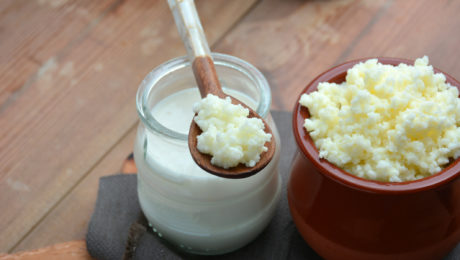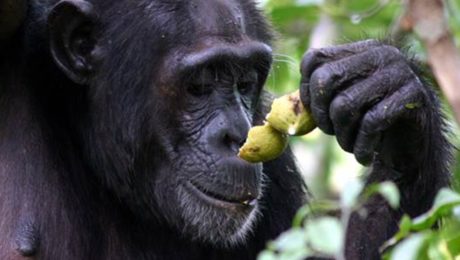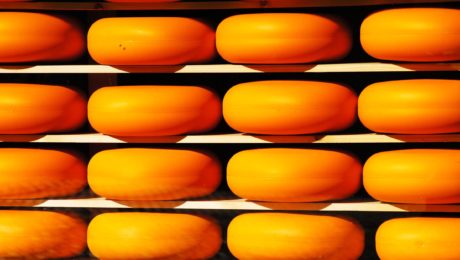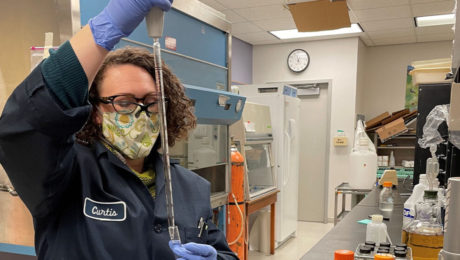“One Grain to Bind Them All”
A new study on kefir found that the individual dominant species of Lactobacillus bacteria in kefir grains cannot survive in milk on their own. The bacteria need one another to create the fermented dairy drink, “feeding on each other’s metabolites in the kefir culture.”
The research, conducted by EMBL (Europe’s laboratory for life and sciences) and Cambridge University’s Patil group and published in Nature Microbiology, illustrates a dynamic of microbes that had eluded scientists. Though scientists knew microorganisms live in communities and depend on each other to survive, “mechanistic knowledge of this phenomenon has been quite limited,” according to a press release on the research.
“Cooperation allows them to do something they couldn’t do alone,” says Kiran Patil, group leader and author of the paper. “It is particularly fascinating how L. kefiranofaciens, which dominates the kefir community, uses kefir grains to bind together all other microbes that it needs to survive — much like the ruling ring of the Lord of the Rings. One grain to bind them all.”
To make kefir, it takes a team. A team of microbes.
The group studied 15 samples of kefir, one of the world’s oldest fermented food products. Below are highlights from a press release on the published results.
A Model of Microbial Interaction
Kefir first became popular centuries ago in Eastern Europe, Israel, and areas in and around Russia. It is composed of ‘grains’ that look like small pieces of cauliflower and have fermented in milk to produce a probiotic drink composed of bacteria and yeasts.
“People were storing milk in sheepskins and noticed these grains that emerged kept their milk from spoiling, so they could store it longer,” says Sonja Blasche, a postdoc in the Patil group and an author of the paper. “Because milk spoils fairly easily, finding a way to store it longer was of huge value.”
To make kefir, you need kefir grains, which must come from another batch of kefir. They cannot be made artificially. The grains are added to milk, to ferment and grow. Approximately 24 to 48 hours later (or, in the case of this research, 90 hours later), the kefir grains have consumed the available nutrients. The grains have grown in size and number, and are removed and added to fresh milk — to begin the process anew.
For scientists, kefir is more than just a healthy beverage: it’s an easy-to-culture model microbial community for studying metabolic interactions. And while kefir is quite similar to yogurt in many ways – both are fermented or cultured dairy products full of ‘probiotics’ – kefir’s microbial community is far larger, including not just bacterial cultures but also yeast.
A “Goldilocks Zone”
While scientists know that microorganisms often live in communities and depend on their fellow community members for survival, mechanistic knowledge of this phenomenon has been quite limited. Laboratory models historically have been limited to two or three microbial species, so kefir offers – as Patil describes – a ‘Goldilocks zone’ of complexity that is not too small (around 40 species), yet not too unwieldy to study in detail.
Blasche started this research by gathering kefir samples from several sources. Though most were obtained in Germany, they may have originated elsewhere, grown from kefir grains passed down through the years..
“Our first step was to look at how the samples grow. Kefir microbial communities have many member species with individual growth patterns that adapt to their current environment. This means fast- and slow-growing species and some that alter their speed according to nutrient availability,” Blasche says. “This is not unique to the kefir community. However, the kefir community had a lot of lead time for coevolution to bring it to perfection, as they have stuck together for a long time already.”
Cooperation is key
Finding out the extent and nature of cooperation among kefir microbes was far from straightforward. Researchers combined a variety of state-of-the-art methods, such as metabolomics (studying metabolites’ chemical processes), transcriptomics (studying the genome-produced RNA transcripts) and mathematical modelling. These processes revealed not only key molecular interaction agents like amino acids, but also the contrasting species dynamics between grains and milk.
“The kefir grain acts as a base camp for the kefir community, from which community members colonise the milk in a complex yet organised and cooperative manner,” Patil says. “We see this phenomenon in kefir, and then we see it’s not limited to kefir. If you look at the whole world of microbiomes, cooperation is also a key to their structure and function.”
In fact, in another paper from Patil’s group (in collaboration with EMBL’s Bork group) in Nature Ecology and Evolution, scientists combined data from thousands of microbial communities across the globe – from in soil to in the human gut – to understand similar cooperative relationships. In this second paper, the researchers used advanced metabolic modelling to show that the co-occurring groups of bacteria, groups that are frequently found together in different habitats, are either highly competitive or highly cooperative. This stark polarization hadn’t been observed before, and sheds light on evolutionary processes that shape microbial ecosystems. While both competitive and cooperative communities are prevalent, the cooperators seem to be more successful in terms of higher abundance and occupying diverse habitats — stronger together!
Primates & Fermented Food
Humans have been fermenting for thousands of years; now, an anthropologist has published evidence that several other primate species also feed on fermented food.
Katherine Amato, at Northwestern University, compiled evidence from 151 biologists who study the feeding habits of 40 primate species from Asia, Africa and the Americas. Fifteen of those species consume fruit in the late stages of fermentation, and thatermented fruit makes up 3% of their diet. Though the scale is small, the evolutionary roots are interesting.
“Of the 44 types of fruit eaten in an advanced state of fermentation, 16 had tough husks that the animals could not easily open unless they were first fermented, and 25 contained digestion-impeding or toxic chemicals like tannins and alkaloids that fermentation tends to destroy,” reads an article in The Economist on the research.
It continues: “Several of the fermented-fruit-eating primates alive today split off from the line that leads to people well over 10m years ago. Presumably, they have evolved their own genetic arrangements for dealing with fermentation products and the microbes that produce them. Nevertheless, Dr. Amato’s work suggests that human beings’ love of the fermented does, indeed, have deep evolutionary roots.”
Read more (The Economist)
- Published in Science
The New Definition of Fermented Food
After Dr. Bob Hutkins finished a presentation on fermented foods during a respected nutrition conference, the first audience question was from someone with a PhD in nutrition: “What are fermented foods?”
“I thought ‘Doesn’t everyone know what fermentation is?’ I realized, we do need a definition. Those of us that work in this field know what we’re talking about when we say fermented foods, but even people trained in foods do not understand this concept,” says Hutkins, a professor of food science at the University of Nebraska-Lincoln. He presented The New Definition of Fermented Foods during a webinar with TFA.
Hutkins was part of a 13-member interdisciplinary panel of scientists that released a consensus definition on fermented foods. Their research, published this month in Nature Reviews Gastroenterology & Hepatology, defines fermented foods as: “foods made through desired microbial growth and enzymatic conversions of food components.”
“We needed a definition that conveyed this simple message of a raw food turning into a fermented food via microorganisms,” Hutkins says. “It brings some clarity to many of these issues that, frankly, people are confused about.”
David Ehreth, president and founder of Alexander Valley Gourmet, parent company of Sonoma Brinery (and a TFA Advisory Board member), agreed that an expert definition was necessary.
“As a producer, and having started this effort to put live culture products on the standard grocery shelf, I started doing it as a result of unique flavors that I could achieve through fermentation that weren’t present in acidified products,” Ehreth says. “Since many of us put this on our labels, we should be paying close attention to what these folks are doing, since they are the scientific backbone of our industry.”
Hutkins calls fermented foods “the original shelf-stable foods.” They’ve been used by humankind for over thousands of years, but have mushroomed in popularity in the last 15. Fermented foods check many boxes for hot food trends: artisanal, local, organic, natural, healthy, flavorful, sustainable, innovative, hip, funky, chic, cool and Instagram-worthy.
Nutrition, Hutkins hypothesizes, is a big driver of the public’s interest in fermentation. He noted that Today’s Dietitian has voted fermented foods a top superfood for the past four years.
Evidence to make bold claims about the health benefits of fermentation, though, is lacking. Hutkins says there is observational and epidemiological evidence. But randomized, human clinical trials — “the highest evidence one can rely on” — are few and small-scale for fermented foods.
Hutkins shared some research results. One study found that Korean elders who regularly consume kimchi harbor lactic acid bacteria (LAB) in their GI tract, providing compelling evidence that LAB survives digestion and reaches the gut. Another study of cultured dairy products, cheese, fermented vegetables, Asian fermented products and fermented drinks found that most contain over 10 million LAB per gram.
Still, the lack of credible studies is “a barrier we have to get past,” Hutkins says. There are confirmed health benefits with yogurt and kefir, but this research was funded by the dairy industry, a large trade group with significant resources.
“I think there’s enough evidence — most of it through these associated studies — to warrant this statement: fermented foods, including those that contain live microorganisms, should be included as part of a healthy diet.”
Zilber on Leaving Noma for Bioscience Corporation
A sustainable food industry will be built by flavor, says David Zilber, noted chef and food scientist.
Zilber made major headlines and surprised many in October when he left his job as head of the fermentation lab at Noma for a food scientist position at Chr. Hansen, a global supplier of bioscience ingredients. Noma, a two-Michelin star restaurant in Copenhagen, Denmark, has been regularly ranked one of the best restaurants in the world. In 2018, Zilber co-authored a bestselling book on fermentation with Noma co-owner Rene Redzepi.
In an Instagram live interview last week with Al Jeezera’s Femi Oke, Zilber elaborated on why he traded an apron for a lab coat. The global food system, Zilber says, is unsustainable. Waste is prevalent, food is created with long footprints, agricultural production is shrinking, meat is heavily consumed and large corporations control the industry.
Transforming Vegetables
“What I’m trying to do in my work is to make vegetables as God damn tasty as they can possibly be by using microbes, using things that are already at our disposal, and convincing people that this might have to have a little bit of a longer inventory life while you let it ferment, while you build a stockpile, but this is the result, this is why you’ll be able to convince people why eating this way is healthy for them and the planet,” he says. “Flavor is king.”
Ingredients created by Denmark-based Chr. Hansen (the company has 40,000 microbial strains used as natural ingredients) feed 1-1.5 billion people a day. These include microbes in yogurt and yeast in beer.
“I work with them to try and make the food system more sustainable, to get more people eating vegetables,” Zilber says, adding that 30% of every calorie consumed by humans is fermented by bacteria, microbes or fungus. “No matter what we eat in the future, that’s still going to be the case. That slot of the human diet still needs some form of microbial transformation, whether it’s meat or dairy or oat milk or peas. I work to figure that out.”
It’s a different philosophy compared to the food technology many new companies are utilizing to create alternative proteins like Beyond Burger. He complimented the company for their high standards, but he says a Beyond Burger patty is not a replacement for a juicy, beef burger. People pay more for an inferior eating experience.
“At the end of that day, that will not cut it,” Zilber says. “Why does food have to be that processed to be purportedly that delicious? With some skilled tricks in the kitchen, with some ninja jiu jitsu behind the stove, you can make vegetables really, really delicious.”
Sustainable Food Systems
A sustainable food system will look much like one from 300 years ago, Zilber hypothesizes. It will be localized, where people purchase food produced close by. Modern practices of shipping ingredients and processed food around the globe are harmful to the environment.
“A truly sustainable food system looks far more decentralized than [the current one] does right now. There are [only a] very few stakeholders that are responsible for really a lot of calories,” he continues.
Oke questioned how Zilber could change a broken food system controlled by large companies when he now works at one of the major companies.
“If you want to be an idealist, that’s great, you might end up being a martyr,” Zilber says. “Sometimes you have to work within those contradictory institutions to try to do as much good as possible.”
Restaurant Industry’s Responsibility
The restaurant industry plays a part in it too, Zilber says. Workers are stretched thin, overworked, underpaid “and then extremely vulnerable in a time of crisis.” The pandemic has exposed and highlighted these problematic parts of the restaurant business.
Zilber says there are still too many restaurants. It’s hard to find good cooks, and staff is often undertrained.
“I took a step into food production myself. Maybe more of these cooks, more of these people who are passionate about food, need to consider options beyond just the restaurant setting and see value in becoming a farmer, becoming a distributor, becoming someone who decides how those calories are made because restaurants aren’t the full picture of the food system,” he continues. “There are a lot of talented people within it who know food, who understand it, who understand the human experience of what it means to make good tasting food and satisfying food. There’s other places for them to work as well.”
- Published in Business
Are Fermented Foods Probiotics?
Probiotics and fermented foods are not equivalent, says Mary Ellen Sanders, PhD and executive science officer of the International Scientific Association of Probiotics & Prebiotics (ISAPP). She advises fermented food producers that don’t meet the criteria of a probiotic to use descriptors such as “live active cultures” or “fermented food with live microbes” on their labels rather than “probiotic.”
“There are quite a few differences between probiotics and many fermented foods. You cannot assume a fermented food is a probiotic food even if it has live cultures present,” says Sanders. She highlighted her 30 years worth of insight into the field during a TFA webinar, Are Fermented Foods Probiotics?
Some fermented foods do meet these criteria, such as some yogurts and cultured milks that are well-studied. But many traditional fermented foods do not.
Using multiple peer-reviewed scientific studies and conclusion from expert panels in the fields of probiotics and fermented foods, Sanders shared the ways in which fermented foods and probiotics differ:
- Health benefits
By definition, a probiotic must have a documented health benefit. Many fermented foods have not been tested for a health benefit.
“If you are interested in recommending health benefits from a fermented food in an evidence-based manner, many traditional fermented foods fall short. They don’t have the controlled randomized trials that will provide a causal link between the food and the health benefit,” she says. “A food may be nutritious, but probiotic benefits must stem from the live microbe, not the nutritional composition of the food. Otherwise you just have a nutritious food that happens to have live microorganisms in it. You don’t have a probiotic food.”
- Quality studies
In her presentation, Sanders shared multiple randomized clinical trials on human subjects with supported health evidence for probiotics. But there are few randomized, controlled studies on fermented foods. Most are cohort studies, which inherently have a higher risk of bias and cannot provide a causal link between consuming fermented foods and a health benefit.
“A strong hypothesis is not the same as proof,” Sanders says. “Evidence for probiotics must meet a higher standard than small associative studies, many of which are tracking biomarkers and not health endpoints.”
She noted, though, there are some studies on fermented milk and yogurt that show a conferred health benefit.
- Strain designation
Though many fermented foods do have live microbes, a probiotic is required to be identified to the strain level. The genus and species should also be properly named according to current nomenclature. Many fermented foods contain undefined microbial composition. Without that strain designation, one can’t tie the scientific evidence on that strain to the probiotic product.
- Microbe quantity
Another key differentiator is that probiotics must be delivered at a known quantity that matches the amount that results in a health benefit. Probiotics are typically quantified in colony forming units (or CFUs).
“A probiotic has a known effective dose. But fermented foods often contain unknown levels of microbes, especially at time of consumption,” Sanders says.
What Can Brands Do?
If food brands keep using the word probiotics as a catch-all to describe a fermented product, the term will lose its utility. Using “probiotics” on food with unsubstantiated proof of probiotics is a misuse of the term.
“When I see a fermented food that says probiotics on it, I very often think what they’re trying to communicate on that label [is that it] contains live microbes,” Sanders says, “because I’m doubting, at least some of the products I see, that they have any evidence of a health benefit. And so they’re just looking for a catchy, single word that will communicate to people that this has live microbes in it. ‘Live active cultures’ is something that resonates with people as well. So why not use that?”
Sanders encourages fermented brands to standardize the terms “live active cultures,” “live microbes,” “live microorganisms” or “fermented food with live microbes.” For products pasteurized after fermentation, there’s a term for them too: “Made with live cultures.”
Controlled human studies on fermented foods can be challenging, Sanders admits. Such studies can be difficult to properly blind, since placebos for foods are hard to design. The fermentation process affects the product taste so that study subjects may know what they are consuming. But the health benefits of fermented foods could be studied, though. She also advises producers to focus on the nutritional value of their food.
“That’s one thing that really has me excited about this concept of core benefits,” says Maria Marco, PhD, professor of food science and technology at University of California, Davis (and a member of TFA’s Advisory Board) and moderator of the webinar. “I think it kind of opens the doors to the possibility of fermented fruits and vegetables where there’s certain organisms, microorganisms that we’d expect to be there but again we need to know really if those microorganisms are needed to make those foods healthy.”
Cheese Doesn’t Deserve Its Bad Reputation
Why do we treat cheese like a guilty pleasure when studies have shown time and again that cheese can be good for you? An article in Wired sheds light on how cheese gained its designation as a villain in the food pyramid. One key element is how many Americans ate in the ‘80s and ‘90s, layering pizza and pasta with heavily-processed cheese.
The article reads: “In the case of cheese, there could be several reasons for the surprising lack of impact on weight, though more research is needed. Cheese is fermented, meaning it has live bacterial cultures. That could have a positive effect on the gut microbiome, which appears to play a role in weight regulation. The fermentation process also creates vitamin K2, or menaquinone, which experimental studies have linked to improved insulin function. Insulin regulates blood sugar levels, hunger, calorie expenditure, and fat storage. (One upshot is that hard, aged cheeses, which are more fermented, probably provide more benefit than soft, less fermented ones.) There’s also some promising research about the benefits of a compound called the milk-fat globule membrane, which is intact in cheese but not in milk or butter.”
Read more (Wired)
EATLAC Studies, Educates on Fermentation
A new project is aiming to provide accurate information and resources to the public around the microbial mysteries of fermented foods. EATLAC is a University of California, Davis, project putting scientific knowledge and research behind fermentation.
“A good understanding of food and beverage fermentation is particularly important for people making fermented foods at home so that the foods are made properly and minimize the risk of foodborne illness,” says Maria Marco, PhD, microbiologist and professor in the department of food science and technology at the university (and member of TFA’s Advisory Board). “Access to accurate information about fermented foods is quite important for understanding their roles in healthy diets and what properties about them are different from the starting ingredients.”
EATLAC officially launched in 2019, with the help of funding from California Department of Food & Agriculture. Led by project directors Marco and Erin DiCaprio, PhD, a food safety expert and extension specialist at UC Davis, the EATLAC team is composed of grad and undergrad students helping to develop science-based guidance on fermented vegetables and fruits. Resources being developed in the project include recipes, consumer surveys, and webinars. This information will be available to the general public, from home fermenters to commercial producers.
The name EATLAC stands for Evaluating And Testing Lacto-ferments Across the Country, but LAC is also a play on words for lactic acid bacteria, the beneficial bacteria present in fermented foods.
Project objectives include:
- Developing educational materials on fermented foods.
- Conducting public education workshops on fermented foods.
- Measuring the bioactive properties of unpasteurized (fresh) fermented fruits and vegetables produced from specialty crops in California.
- Disseminating research findings to food processors.
“It is very important to spread reliable information and vetted recipes so that everyone can create something that is great but, more importantly, safe,” says Zoe Mitchell, undergraduate student at UC Davis. “Fermentation requires that food be left out on the counter (in the microbial temperature danger zone) for days on end. To create a safe fermentation environment that supports the growth of the microbes we want, recipe ingredients include things like acid and salt to inhibit pathogens. However, because just a little too much or too little of these ingredients can grow the wrong and potentially dangerous microorganisms, it is paramount to have reliable sources.”
An important role of the student team, Marco says, is to “perform laboratory research to study the microbiota and bioactive properties in fermented fruits and vegetables.” Students will also be responsible for developing informational materials on fermented fruits and vegetables and run the social media accounts.
Natália Ribeiro, doctoral student at UC Davis, has developed aspects of the project communication. She manages the EATLAC Instagram account, coordinates the posts on FaceBook, and is helping create fermentation fact sheets that will be available on the website. Riberio says she decided to join the project because she wanted to study further the health benefits of fermentation.
“There’s so much more to know about fermented foods and map out. We want to spread that information in a more validated way,” Riberio says. “People associate fermented foods with flavor, but in a society where we see so many people dealing with diseases, making fermented foods part of your habits could actually alleviate or improve your health in a very easy and even tasty way. Educating people about what is known (and not) is important.”
Since most of the team is not allowed to be in the laboratory due to the pandemic, they are collecting home ferments for analysis. EATLAC is calling on home fermenters around the country to send in their fresh fruit or vegetable ferments. Fresh ferments are samples taken right after fermentation, before refrigeration. The research group will then study the nutritional content and beneficial bacteria. Mitchell adds this allows the team “to create an extensive database on the microbial ecology of various fermentations.” Elements like ingredients, location, salt percentage and vessel type are all tracked to see how these factors affect fermentation.
The team is currently studying samples from home during the COVID-19 pandemic, but they’re anxious to return to the lab.
“There is a great and long history of food fermentation research at UC Davis,” Marco notes. The team will update existing informational resources and write new ones within EATLAC.
For more information about the educational resources, visit EATLAC webinar series.
Creating Meat Alternatives from Thin Air?
Air Protein, a Bay-area startup, is using NASA-inspired fermentation technology to create an edible protein. The company, which recently received $32 million in funding, is the first to make “air-based” protein, farming carbon from the air with microbes.
The vertical fermentation tanks used by Air Protein combine carbon dioxide, oxygen and nitrogen with water and minerals. “The final products is a protein-rich flour that can be used just like soy or pea flour,” writes the Mercury News. “This protein flour can then be made into a plethora of delicious and nutritious meatless meat products.”
Founder and CEO Lisa Dyson discovered the NASA research while searching for new ways to recycle carbon and address the global climate crisis. She says Air Protein’s technology will “create the most sustainable meat available and significantly reduce the burden on our planet’s resources that is being cased by our current meat production processes.”
Read more (Mercury News)
- Published in Science
Wildfires Cost California Wineries Billions
Devastating recent wildfires need to spur the California wine industry to invest in researching ways to mitigate the effects of fire and smoke damage. The California Wine Institute partnered with firm BW166 to calculate the cost of the 2020 wildfires to wineries; a $3.7 billion estimate includes loss of property, wine inventory, grapes and future sales.
“At a time of year when vintners would typically be throwing harvest parties and stomping grapes, they were instead faced with mounting uncertainty about the viability of their crop. Many of them decided not to make some or all of the wine that they’d planned to bottle because of the smoke damage. Months later, wineries are still deliberating over those decisions,” writes the San Francisco Chronicle.
Read more (San Francisco Chronicle)
- Published in Business
How Does Yeast Interact with Cider Apples?
Researchers at Washington State University are developing a nutrient formula for yeast that could make fermentation easier and more predictable for cider makers.
“Cider apples don’t have as many nutrients for yeast, unlike grapes,” said Claire Warren, a microbiologist for WSU’s School of Food Science. “I want to make a nutrient base for yeast used with cider apples so fermentation can be more predictable batch to batch and year to year.”
The difference between hard cider and apple juice is the role of yeast. Yeast converts the sugar in cider apples into alcohol. Though much is known about how yeast interacts with grapes, little is known about how yeast interacts with apples. Researchers are studying the analytical information behind a cider apple, hoping their research will improve production.
Read more (Washington State University)
- Published in Science










